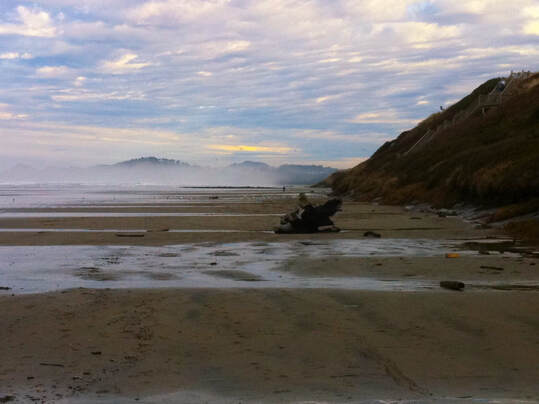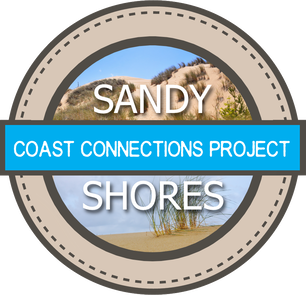Navigate:EDUCATE > COAST CONNECTIONS > SANDY SHORES Entry Events Driving Questions:
Authentic Projects for DQ1: Authentic Projects of DQ2: Authentic Projects of DQ3: |
Authentic Project 2: Our Beach, Our ResponsibilityStudents will investigate the ways that people negatively impact dunes and sandy shores, and ways that both citizens and scientists help mitigate these impacts. Then, they create an informational brochure sharing these impacts and ways we can reduce them.
Purpose: Understanding our impacts on natural environments is important, but it's only the first step. In this project, students will apply their newly-gained knowledge about threats facing our sandy shores to a public outreach campaign designed to spark interest and motivation in keeping our beaches healthy. Authentic Audience: The public community. Group work: Assign students to work in groups of 3-5. Each group should produce their own brochure or other product to promote awareness of our beaches and the threats they face. Have each student take one (or more, depending on group sizes) of the following roles, based on their interests and talents:
See our Guide to Facilitating Student Group Work for more information. Teacher's Role: You are the Project Manager, overseeing students as they learn and create. You will provide each student with the materials they need to fulfill their above roles. You should make sure that students remain on-task and on-deadline while also ensuring that they have the freedom to design their materials however they want. You should also help students make sure that the information they're providing is correct and that their materials are easy to read and visually appealing — since ultimately their projects will be viewed by the public! Related Project Example: Reshaping Rochester - Speading the word brochure |
|
Student research materials:
Vertical Divider
|
Additional Resources:
|
Community Partners:

PREPARE FOR SUCCESS: Use our Guide to Working with Community Partners to contact and secure your partner(s) ASAP.
Potential avenues for students to share their work include:
To find other potential avenues to distribute student products, we encourage you to leverage any personal connections you may have in your community. Talk to the owners of your favorite local shop or restaurant. Ask the organizers of your Farmer's Market if students can set up a table for a few weekends.
If you need more ideas, check out the website for your local Chamber of Commerce for business listings and contact information.
Opportunities for professional engagement:
Potential avenues for students to share their work include:
- Local farmer's markets
- Storefronts (gain permission from store owners first!)
- Beaches and parks
To find other potential avenues to distribute student products, we encourage you to leverage any personal connections you may have in your community. Talk to the owners of your favorite local shop or restaurant. Ask the organizers of your Farmer's Market if students can set up a table for a few weekends.
If you need more ideas, check out the website for your local Chamber of Commerce for business listings and contact information.
Opportunities for professional engagement:
- Contact the Oregon Dunes Restoration Collaborative to arrange an interview or Skype video with staff to discuss the importance of sandy shore ecosystems and species.
- Contact the Oregon Coast Aquarium to arrange an interview or Skype session with a member of our Marketing staff, who can share tips, ideas and feedback for student brochures.
- Ask an Interpretive Ranger from Oregon State Parks to meet your students at the beach and provide expert species identification and other expertise.
- Use your connections! If any parents or family members are involved in marketing, design, or conservation, ask them to visit the classroom as a guest speaker or mentor.
Learning Activities:
What is sand?
What lives in the sand?
What threats do dunes and beaches face?
Why is beach conservation important?
How can we create an impactful brochure
- PBS Deep Look video: The Amazing Life of Sand
- Sand Lab (from SeaWorld/Busch Gardens) - can be used with this student worksheet (from NJ Sea Grant)
What lives in the sand?
- Interstitial Meiofauna activity (from Oregon Institute of Marine Biology). Use with this PowerPoint.
- Sharing Our Shores activity (Audubon Adventures)
What threats do dunes and beaches face?
- Modeling Beach Erosion (from New Jersey Sea Grant): use this activity to demonstrate what is happening to many of Oregon's dunes because of human structures
- Briefly share the information in this article about how non-native plants have negatively impacted Oregon's dunes. Using the Restoring Oregon's Dunes book, share pictures of invasive European Beachgrass and compare it to pictures of dunes without invasive beachgrass. Then, play the Land of Many Opportunists Game. Use the provided discussion questions to review what they learned.
Why is beach conservation important?
- Part 1: Have each student choose one native Oregon sandy beach or dune species to research (that they saw on their field trip or from the Handbook) and create a report or presentation to show how threats to the dunes may specifically impact it.
- Part 2: Watch this video and discuss: How do people negatively impact dunes and sandy beaches? Why do people need healthy dunes?
How can we create an impactful brochure
- Collect a number of varying brochures from your local visitor's center, chamber of commerce, hotel, or other locations that provide information about local destinations. Distribute several to each student group. Ask students to create a report listing the brochures they reviewed, and what they liked and did not like about them.
- Ask students to explore the Top 10 creative tips for brochure design page and share out what they learned.
Field Trips:
- Go on a field trip to a local beach (see the Field Trip Sites section on Page 2). Use the Handbook of Sandy Shore Organisms to search for and identify species. Consult the Handbook for information about the species you see. (NOTE: The Oregon Coast STEM Hub has field trip supplies you can borrow, such as ID guides, boots, and more. Visit their Resource Checkout page to learn more.)
- Visit the Oregon Coast Aquarium and spend time in the Sandy Shores Gallery. Encourage students to observe the adaptations that help these animals survive and make them special.



